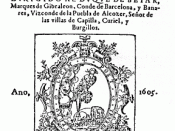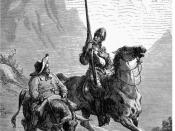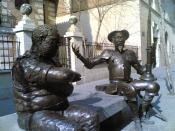High comedy is defined as a comedy that appeals to and reflects the life and problems of the upper social classes, characterized by a witty, sardonic treatment. In comparison to that is low comedy a comedy that gets its effect mainly from action and situation, as burlesque, farce, slapstick, and horseplay, rather than from a witty dialogue and characterization.
The author Samuel Johnson (1709-1784) defines satire as: "A Poem in which wickedness or folly is censored". A satire should include entertainment, critical dimension, and a moral Reform. The novel can not be regarded as crude, slapstick humor (low comedy), but rather, as a warm, human tale, depicting the conflict between noble idealism and brute, unfeeling practicality. Don Quixote is a novel allegorizes high comedy, because it represents the life and the problems of an upper-class gentleman, in a funny and sardonic way. The novel is also a satire; entertainment, critic and a moral reform can be recognized by the readers.
Don Quixote tells the story of the ordinary Spanish gentleman Alonso Quixano, who is addicted to books. He spends every moment engrossed in thick, meandering tomes filled with tales of knights and squires, magicians and giants, and beautiful ladies. He begins to sell parts of his estate in order to buy even more books. He lost his wits, and he decided to roam the country as a knight-errant named Don Quixote de la Mancha. Don Quixote lives in a world created in his imagination, which had been fueled by his obsession with chivalric tales. Instead of battles with evil knights, and rescuing virtuous maidens, he deals with windmills, bedclothes, and much disappointment. Along the way he acquires a sidekick, Sancho Panza, who supports Don Quixote in hopes of getting rich. Master and squire have numerous adventures, often causing...


